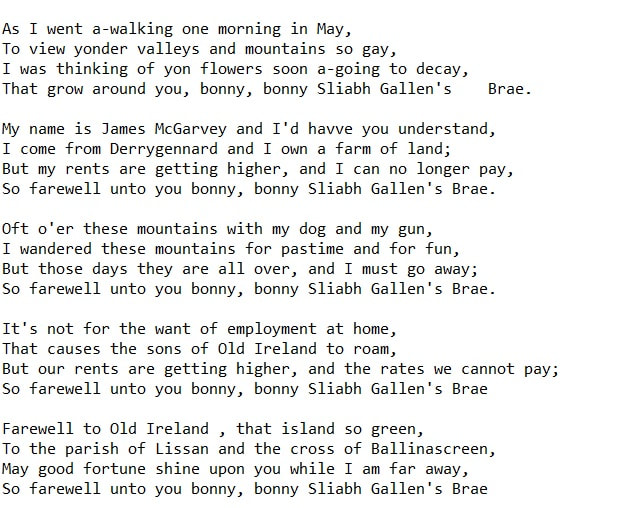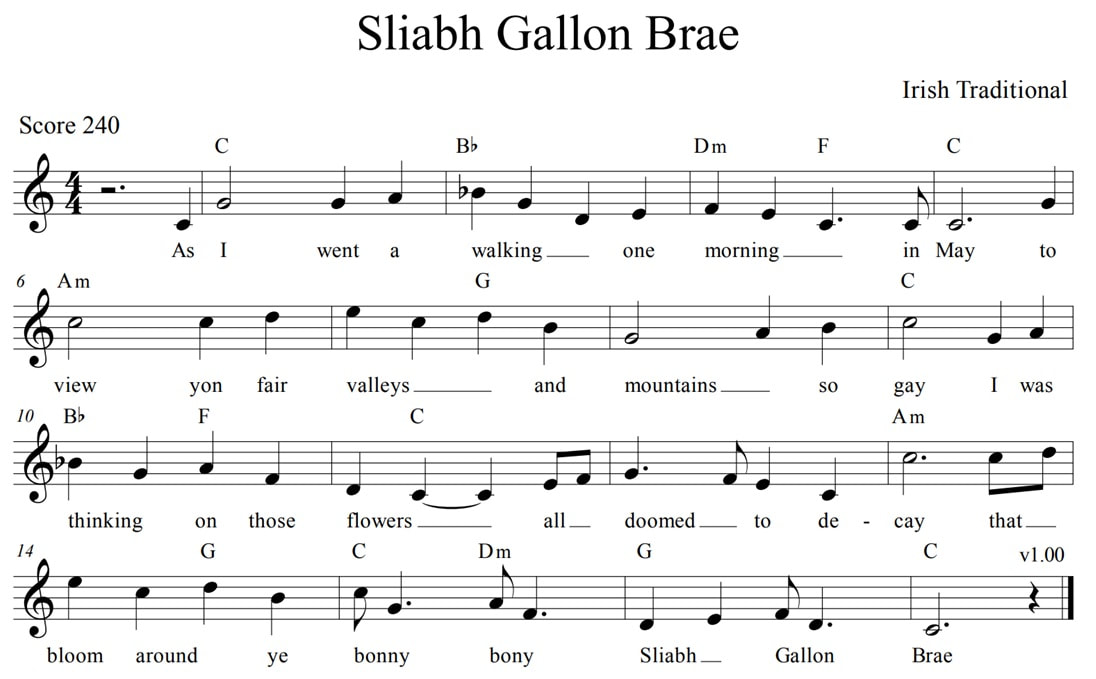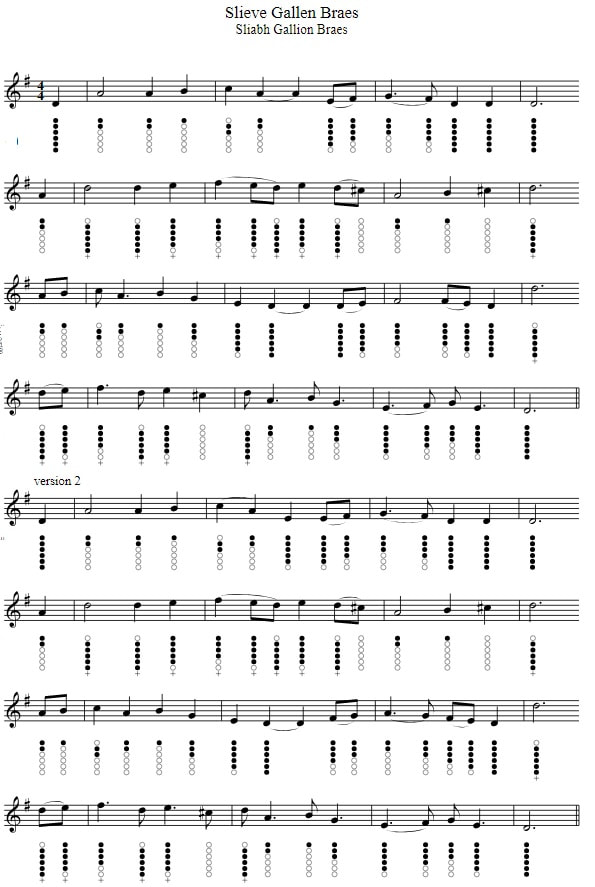Sliabh Gallion Brae Irish lyrics and chords
[ Slieve Gallen Brae ]A traditional song, the video is of singer Gemma Hasson, a beautiful version of this old classic song. The tin whistle sheet music notes are included and can be played on the flute or accordion. It was also recorded by Delores Keane, who is famous for singing My Own Dear Galway Bay [ lyrics ] with John Falkner, Johnny McEvoy and Makem And Clancy. Piano chords included.
Sliabh Gallion Brae Song Words And Chords In C Major
[C]As I went a-[Bb]walking one[Dm] morn[F]ing in[C] May,
To[Am] view yonder val[G]leys and mountains so[C] gay,
I was[Bb] thinking of[F] yon flowers soon a-[C]going to de[Am]cay,
That grow a[G]round you,[C] bonny,[Dm] bonny Sliabh[G] Gallen's [C]Brae.
My name is James McGarvey and I'd havve you understand,
I come from Derrygennard and I own a farm of land;
But my rents are getting higher, and I can no longer pay,
So farewell unto you bonny, bonny Sliabh Gallen's Brae.
Oft o'er these mountains with my dog and my gun,
I wandered these mountains for pastime and for fun,
But those days they are all over, and I must go away;
So farewell unto you bonny, bonny Sliabh Gallen's Brae.
It's not for the want of employment at home,
That causes the sons of Old Ireland to roam,
But our rents are getting higher, and the rates we cannot pay;
So farewell unto you bonny, bonny Sliabh Gallen's Brae [ lyrics ].
Farewell to Old Ireland , that island so green,
To the parish of Lissan and the cross of Ballinascreen,
May good fortune shine upon you while I am far away,
So farewell unto you bonny, bonny Sliabh Gallen's Brae
[C]As I went a-[Bb]walking one[Dm] morn[F]ing in[C] May,
To[Am] view yonder val[G]leys and mountains so[C] gay,
I was[Bb] thinking of[F] yon flowers soon a-[C]going to de[Am]cay,
That grow a[G]round you,[C] bonny,[Dm] bonny Sliabh[G] Gallen's [C]Brae.
My name is James McGarvey and I'd havve you understand,
I come from Derrygennard and I own a farm of land;
But my rents are getting higher, and I can no longer pay,
So farewell unto you bonny, bonny Sliabh Gallen's Brae.
Oft o'er these mountains with my dog and my gun,
I wandered these mountains for pastime and for fun,
But those days they are all over, and I must go away;
So farewell unto you bonny, bonny Sliabh Gallen's Brae.
It's not for the want of employment at home,
That causes the sons of Old Ireland to roam,
But our rents are getting higher, and the rates we cannot pay;
So farewell unto you bonny, bonny Sliabh Gallen's Brae [ lyrics ].
Farewell to Old Ireland , that island so green,
To the parish of Lissan and the cross of Ballinascreen,
May good fortune shine upon you while I am far away,
So farewell unto you bonny, bonny Sliabh Gallen's Brae
Chords in the key of G
[G]As I went a-[F]walking one[Am] morn[C]ing in[G] May,
To[Em] view yonder val[D]leys and mountains so[G] gay,
I was[F] thinking of[C] yon flowers soon a-[G]going to de[Em]cay,
That grow a[D]round you,[G] bonny,[Am] bonny Sliabh[D] Gallen's [G]Brae.
[G]As I went a-[F]walking one[Am] morn[C]ing in[G] May,
To[Em] view yonder val[D]leys and mountains so[G] gay,
I was[F] thinking of[C] yon flowers soon a-[G]going to de[Em]cay,
That grow a[D]round you,[G] bonny,[Am] bonny Sliabh[D] Gallen's [G]Brae.
The Sliabh Gallion Brae Irish song is a traditional Irish folk song that has captured the hearts and minds of the Irish people for centuries. This iconic song has been passed down through generations, becoming a vital part of the country's cultural heritage. It tells a story of love, loss, and the enduring spirit of the Irish people.
The Sliabh Gallion Brae is a mountain located in the Sperrin Mountains in County Tyrone, Northern Ireland. The Irish word 'sliabh' means mountain, and 'gallion' is thought to be derived from the Irish word 'gal,' meaning 'valor.' This translates to 'the mountain of valor,' highlighting the significance of this mountain in Irish history and culture.
The song itself is a ballad, with a slow and melancholic melody that captures the essence of Irish folk music. Its lyrics are in the Irish language, also known as Gaelic, which adds to the song's authenticity and cultural significance. The song has been translated into English, but its true meaning and emotion are best understood in its original language.
The lyrics of the Sliabh Gallion Brae song tell the story of a young woman who is deeply in love with a man from a neighboring village. She longs to be with him, but their love is forbidden due to a feud between their families. The man is called away to war, and the young woman is left heartbroken and alone. She sings of her love for him and her longing for his return, but tragically, he does not come back. The song's final verse is a lament for the loss of her beloved, and the woman's broken heart is a symbol of the enduring pain of the Irish people throughout history.
The Sliabh Gallion Brae song is not just a love story; it is a reflection of the struggles and resilience of the Irish people. Ireland has a long history of conflict and oppression, from the Viking invasions to the British colonization. This song speaks to the enduring spirit of the Irish people, who have faced adversity time and time again and have emerged stronger each time.
The song's origins can be traced back to the 17th century, and it has been passed down orally through the generations. Its lyrics have evolved over time, with different versions and variations appearing in different regions of Ireland. Despite these changes, the core of the song remains the same, and its message of love and loss resonates with people to this day.
The Sliabh Gallion Brae song has been immortalized in Irish culture, with countless recordings and performances by renowned Irish musicians, such as The Dubliners, The Chieftains, and Mary Black. It has also made its way into popular culture, featuring in movies and TV shows, further cementing its place in Ireland's cultural identity.
One notable performance of the Sliabh Gallion Brae song was at the 1996 Eurovision Song Contest, where Irish singer Eimear Quinn won with her rendition of the song. This victory brought the song to a wider international audience and solidified its place as one of Ireland's most beloved folk songs.
In conclusion, the Sliabh Gallion Brae Irish song is a treasured part of Ireland's rich cultural heritage. Its poignant lyrics, haunting melody, and timeless message have captured the hearts of the Irish people and continue to be passed down through generations. This song serves as a reminder of the enduring spirit and resilience of the Irish people, and its legacy will continue to live on for generations to come.
The Sliabh Gallion Brae is a mountain located in the Sperrin Mountains in County Tyrone, Northern Ireland. The Irish word 'sliabh' means mountain, and 'gallion' is thought to be derived from the Irish word 'gal,' meaning 'valor.' This translates to 'the mountain of valor,' highlighting the significance of this mountain in Irish history and culture.
The song itself is a ballad, with a slow and melancholic melody that captures the essence of Irish folk music. Its lyrics are in the Irish language, also known as Gaelic, which adds to the song's authenticity and cultural significance. The song has been translated into English, but its true meaning and emotion are best understood in its original language.
The lyrics of the Sliabh Gallion Brae song tell the story of a young woman who is deeply in love with a man from a neighboring village. She longs to be with him, but their love is forbidden due to a feud between their families. The man is called away to war, and the young woman is left heartbroken and alone. She sings of her love for him and her longing for his return, but tragically, he does not come back. The song's final verse is a lament for the loss of her beloved, and the woman's broken heart is a symbol of the enduring pain of the Irish people throughout history.
The Sliabh Gallion Brae song is not just a love story; it is a reflection of the struggles and resilience of the Irish people. Ireland has a long history of conflict and oppression, from the Viking invasions to the British colonization. This song speaks to the enduring spirit of the Irish people, who have faced adversity time and time again and have emerged stronger each time.
The song's origins can be traced back to the 17th century, and it has been passed down orally through the generations. Its lyrics have evolved over time, with different versions and variations appearing in different regions of Ireland. Despite these changes, the core of the song remains the same, and its message of love and loss resonates with people to this day.
The Sliabh Gallion Brae song has been immortalized in Irish culture, with countless recordings and performances by renowned Irish musicians, such as The Dubliners, The Chieftains, and Mary Black. It has also made its way into popular culture, featuring in movies and TV shows, further cementing its place in Ireland's cultural identity.
One notable performance of the Sliabh Gallion Brae song was at the 1996 Eurovision Song Contest, where Irish singer Eimear Quinn won with her rendition of the song. This victory brought the song to a wider international audience and solidified its place as one of Ireland's most beloved folk songs.
In conclusion, the Sliabh Gallion Brae Irish song is a treasured part of Ireland's rich cultural heritage. Its poignant lyrics, haunting melody, and timeless message have captured the hearts of the Irish people and continue to be passed down through generations. This song serves as a reminder of the enduring spirit and resilience of the Irish people, and its legacy will continue to live on for generations to come.




